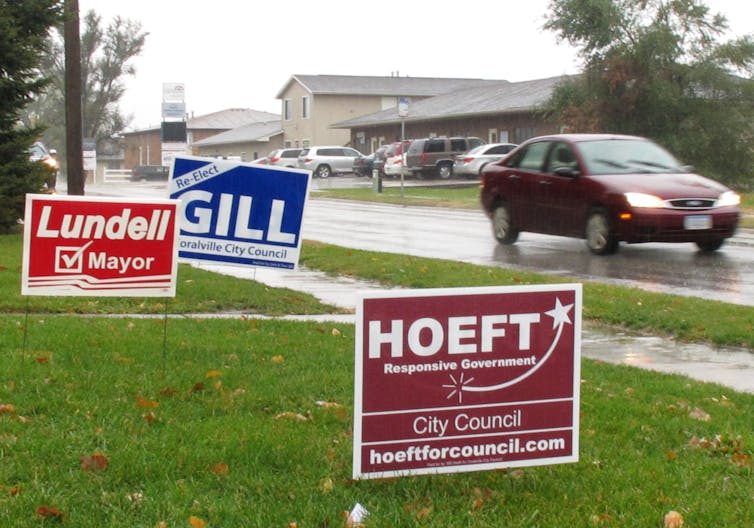Public radio can help solve the local news crisis -- but that would require expanding staff and cove
The local news crisis is more than a problem of shuttered newsrooms and laid-off journalists. It’s a democracy crisis. And public radio can help fix it. But it needs more money and staff to do that.

Since 2005, more than 2,500 local newspapers, most of them weeklies, have closed, with more closures on the way.
Responses to the decline have ranged from luring billionaires to buy local dailies to encouraging digital startups. But the number of interested billionaires is limited, and many digital startups have struggled to generate the revenue and audience needed to survive.
The local news crisis is more than a problem of shuttered newsrooms and laid-off journalists. It’s also a democracy crisis. Communities that have lost their newspaper have seen a decline in voting rates, the sense of solidarity among community members, awareness of local affairs and government responsiveness.
Largely overlooked in the effort to save local news are the nation’s local public radio stations.
Among the reasons for that oversight is that radio operates in a crowded space. Unlike a local daily newspaper, which largely has the print market to itself, local public radio stations face competition from other stations. The widely held perception that public radio caters to the interests of people with higher income and education may also have kept it largely out of the conversation.
But as a scholar who studies media, I believe that local public radio should be part of the conversation about saving local news.

Advantages are trust, low cost and reach
There are reasons to believe that public radio can help fill the local news gap.
Trust in public broadcasting ranks above that of other major U.S. news outlets. Moreover, public radio production costs are relatively low – not as low as that of a digital startup, but far less than that of a newspaper or television station. And local public radio stations operate in every state and reach 98% of American homes, including those in news deserts – places that today no longer have a daily paper.
Finally, local public radio is no longer just radio. It has expanded into digital production and has the potential to expand further.
To assess local public radio’s potential for helping to fill the local information gap, I conducted an in-depth survey of National Public Radio’s 253 member stations.
The central finding of that study: Local public radio has a staffing problem. Stations have considerable potential but aren’t yet in a position to make it happen.
That’s not for lack of interest. Over 90% of the stations I surveyed said they want to play a larger role in meeting their community’s information needs. As one of our respondents said, “The need for the kind of journalism public media can provide grows more evident every day. The desire on the part of our newsrooms is strong.”
To take on a larger role, most stations would need to expand their undersized news staff.
Sixty percent of the local stations have 10 or fewer people on their news staff, and that’s by a generous definition of what constitutes staff. Respondents included in this count broadcast and digital reporters, editors, hosts, producers and others who contribute to local news and public affairs content in its various forms, as well as those who directly provide technical or other support to those staff members. In addition to full-time employees, stations were asked to include part-time employees and any students, interns or freelancers who contribute regularly.
The staffing problem is most acute in communities that have lost their newspaper or where local news gathering has been sharply cut back. Many of these communities were judged by the respondents to have a below-average income level, which limits the local station’s fundraising potential.
Although the staffing problem is more pronounced at stations in communities where local news is in short supply, staff size at nearly every station falls far short of even a moderate-sized daily newspaper.
The Des Moines Register, for example, has a daily circulation of 35,000 copies and a nearly 50-person newsroom – a staff larger than 95% of local public radio stations.
Limitations on potential
One consequence of the staffing problem is that local public radio is actually not all that “local.”
The survey found that in the 13-hour period from 6 a.m. to 7 p.m. on weekdays, only about two hours of locally produced news programming was carried on the average station, some of it in the form of talk shows and some of it as repeat programming. For stations with a news staff of 10 or fewer people, the daily average of locally produced news – even when including repeat programming – is barely more than one hour.
This is only one indicator of the limitations of an undersized newsroom.
Stations with a news staff of 10 or fewer people, for example, were only half as likely as those with more than 20 to have a reporter routinely assigned to cover local government. Some stations are so short of staff that they do not do any original reporting, relying entirely on other outlets, such as the local newspaper, for the stories they air.
A small news staff also means it’s hard to create content for the web, as illustrated by stations’ websites. The stations with 10 or fewer people in their newsroom were only half as likely as those with a staff size of more than 10 to feature local news on their homepage. A local station’s website cannot become the “go-to” place for residents seeking local news on demand if the station fails to provide it.

The stakes for democracy
With more staff, local public radio stations could help fill the information gap created by the decline of local newspapers. They could afford to assign a reporter full time to cover local government bodies like city councils and school boards.
It would still be a challenge for stations in rural areas that include multiple communities, but that challenge is also one that newspapers in rural areas have always faced and have in the past found ways to manage.
With adequate staff, local stations could also make their programming truly “local,” which would broaden their audience appeal.
Programming created by NPR, Public Radio International and other content providers accounts for much of the appeal of local stations. But it can be a handicap in areas where many potential listeners have values and interests that aren’t met by national programming and where the station offers little in the way of local coverage. As one respondent noted, stations must provide coverage “that reflects the entirety of their communities.”
How much new money would local stations require to expand their coverage? Based on our respondents’ estimates and a targeting of the funding for the communities most in need, roughly $150 million annually would be required.
Given that these communities tend also to be the ones in below-average income areas, the funding would have to come largely from outside sources. That won’t be easy, but it needs to get done. As the Knight Foundation’s Eric Newton noted, local news gives people the information they “need to run their communities and their lives.”
Thomas E. Patterson does not work for, consult, own shares in or receive funding from any company or organization that would benefit from this article, and has disclosed no relevant affiliations beyond their academic appointment.
Read These Next
Karoline Leavitt’s White House briefing doublethink is straight out of Orwell’s ‘1984’
A historian analyzes how White House press secretary Karoline Leavitt’s claims about her boss and…
Where the wild things thrive: Finding and protecting nature’s climate change safe havens
Protecting places that are likely to remain cool and moist as global temperatures rise can save wildlife…
Billionaires with $1 salaries – and other legal tax dodges the ultrawealthy use to keep their riches
The richest Americans can largely avoid paying income and other taxes. A new book explains the history.






